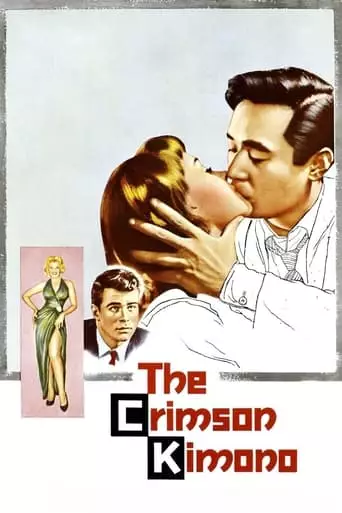
The Crimson Kimono (1959) Watch Online Free
A Los Angeles detective and his Japanese partner woo an artist while solving a stripper’s murder.
The Crimson Kimono is a 1959 American crime film directed by Samuel Fuller. The film takes place in Los Angeles’ Little Tokyo district and begins with the murder of a burlesque dancer, Sugar Torch. Two detectives, Joe Kojaku (James Shigeta) and Charlie Bancroft (Glenn Corbett), investigate the case. The dancer had been preparing a new act featuring Japanese themes, and the killer shot her after defacing a painting of her in a crimson kimono.
As the investigation unfolds, the detectives discover the dancer had been involved with a Japanese art expert named Hansel. The film takes a unique turn when Christine Downs (Victoria Shaw), an art student who had painted the crimson kimono, becomes a central figure. Both detectives fall in love with her, but Joe, the Japanese-American detective, struggles with racial insecurities, feeling that his heritage might stand in the way of his relationship with Christine.
The investigation eventually leads to a tragic conclusion when the killer, a woman misled by jealousy, confesses to the crime. Joe, realizing his own misinterpretations about race and love, reconciles with his partner Charlie and pursues a relationship with Christine.
The film is notable for its treatment of race, particularly in its portrayal of an interracial love triangle. In 1959, Hollywood rarely depicted interracial relationships positively, but The Crimson Kimono broke this norm. Joe’s internal conflict about his racial identity and his fears about being rejected because of it are central to the film’s narrative. His emotional struggle highlights the challenges faced by Asian-Americans in a predominantly white society, and the film subtly critiques societal prejudices.
Another key theme is the idea of misperception. The murder is driven by a misunderstanding, and Joe’s own racial misperceptions cause tension with his friend Charlie and love interest Christine. This theme is explored through Joe’s journey of self-realization, as he learns that his fears about rejection were unfounded. The film suggests that true understanding and love can only come when individuals break free from these misperceptions.
Additionally, the setting of Little Tokyo provides a rich backdrop for exploring cultural identity. The district serves not only as a physical location but as a symbol of the cultural divide that Joe feels torn between. The film uses the neighborhood’s vibrant Japanese-American community to explore themes of alienation and cultural assimilation.
The Crimson Kimono is a pioneering work in Hollywood’s portrayal of race relations. It was one of the first films to depict an interracial romance in a positive light, something that was still controversial at the time. The film’s handling of race was ahead of its time, offering a nuanced portrayal of Japanese-American identity and the complexities of navigating love and friendship in a racially divided society.
The film also helped to establish James Shigeta as a prominent Asian-American actor, breaking stereotypes about Asian roles in Hollywood. His portrayal of Joe Kojaku was groundbreaking, offering a complex, sympathetic character at a time when Asian-American characters were often relegated to stereotypes or supporting roles.
After watching The Crimson Kimono, you may feel a sense of introspection, especially regarding issues of race and identity. The film’s emotional depth, coupled with its exploration of cultural tensions, may leave you contemplating the complexities of human relationships and societal prejudices. The film’s resolution, which centers on reconciliation and understanding, offers a hopeful message, making it both a thought-provoking and emotionally satisfying experience.
The themes of misperception and cultural alienation might resonate with viewers, especially those who have experienced similar struggles with identity or belonging. The film’s subtle critique of racial divides will likely leave you with a deeper appreciation for the nuances of social dynamics, particularly in the context of interracial relationships.
